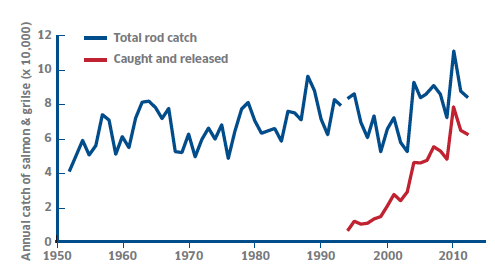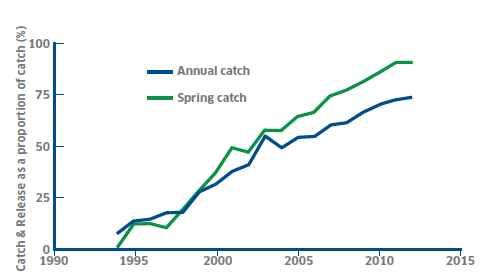Provisional Salmon Fishery Statistics - 2012 Season
Provisional salmon fishery statistics are published to provide an early indication of the performance of the fishery. The status of salmon stocks, largely as derived from fishery data, will be considered with the publication of the final statistics later
// PROVISIONAL SALMON FISHERY STATISTICS - 2012 SEASON
Summary
- Total reported rod catch (retained and released) for 2012 is 84,950 salmon. It is the 10th highest rod catch on record, and is 94% of the previous 5-year average.
- The proportion of the rod catch accounted for by catch and release is the highest recorded. In 2012, 91% of rod caught spring salmon was released, as was 74% of the annual rod catch.
- Trends in rod catch vary among individual stock components. Reported catch of spring salmon shows a general decline since records began and, although there is some indication that spring salmon catch has stabilised in recent years, it re mains at a historically low level. Grilse catch, on the other hand, has generally increased over the period while the catch of summer salmon shows little overall trend.
- Catch and effort for both fixed engine and net & coble
fisheries remain at historically low levels. Reported catch in
each fishery was 12,580 and 3,646; 5% and 1% of the maximum
reported in the respective time series. Fishing effort in these
fisheries was 236.5 trap months and 78.5 crew months; the fifth
and sixth lowest, respectively, since records began in 1952.
- Provisional data presented here are a summary of the data from 1,823 forms returned from 2,016 forms originally issued (90% return rate) for the 2012 season. Return rates for the final published statistics for the previous 10 years have been between 93% and 96%.
Publication of provisional salmon fishery statistics
Provisional salmon fishery statistics are published to provide an early indication of the performance of the fishery. The status of salmon stocks, largely as derived from fishery data, will be considered with the publication of the final statistics later in the year.
These data are derived from a lower proportion of forms returned than the final statistics. The provisional statistics for the 2012 season are a summary of the data from 1,823 forms returned from 2,016 forms originally issued (90% return rate). Return rates for the final published statistics for the previous 10 years have been between 93% and 96%
Topic sheet no. 67 explains how we collect the catch statistics and is available for download at http://www.scotland.gov.uk/Topics/marine/science/Publications/Topicsheets/tslist
Provisional data for the 2012 fishing season are available for download by following links from the main Scottish Salmon and Sea Trout Fishery Statistics page at http://www.scotland.gov.uk/Topics/marine/science/Publications/stats/SalmonSeaTroutCatches
The data provided for download are the best available at the time of publication. Our records are amended when further information is provided and the most accurate data may be obtained directly from us. If you have a specific request for Scottish salmon and sea trout fishery information, please contact us directly at ms.catchform@scotland.gsi.gov.uk
// Catch & Effort Reported by Scottish SALMON Fisheries in 2012
The rod and line fishery
22,450 wild salmon and grilse were reported caught and retained in the rod and line fishery. A further 62,500 wild salmon and grilse were reported caught and released. The combined retained and released rod catch was 94% of the previous 5-year average. We have no comprehensive time series of fishing effort information associated with the rod and line fishery.
Trends in rod and line catch are shown in Figure 1. The total rod catch in 2012 (retained and released) has shown a slight increase since records began in 1952 which, together with the decline in the net fisheries, has resulted in the rod and line catch comprising 84% of the total Scottish catch in 2012 compared to 11% in 1952.

Figure 1
Rod and line fishery.
Trends in total rod catch vary among individual stock components. Reported catch of spring salmon shows a general decline since records began and, although there is some indication that spring salmon catch has stabilised in recent years, it remains at a historically low level. Grilse catch has generally increased over the period while the catch of summer salmon shows no clear trend.
Catch and release
The proportion of the rod catch accounted for by catch and release has generally increased since 1994, when such information was first recorded. In 2012, 74% of the annual rod catch was released compared to less than 8% in 1994. Similarly, less than 1% of rod caught spring salmon were released in 1994 while 91% were released in 2012 (Figure 2).

Figure 2
Catch and release, rod and line fishery.
The net fisheries
12,580 wild salmon and grilse were reported caught and retained in the fixed engine fishery, and the national index of netting effort was 236.5 trap months. 3,646 wild salmon and grilse were reported caught and retained in the net & coble fishery, while the reported effort was 78.5 crew months.
Reported catch and effort have declined in both net fisheries over much of the period covered by our records and remain at historically low levels. Fishing effort in the fixed engine and net & coble fisheries were respectively the fifth and sixth lowest since records began in 1952. Catch in these fisheries were 5% and 1% of the maximum recorded in the respective time series.
Contact
There is a problem
Thanks for your feedback